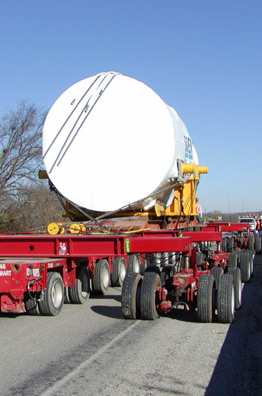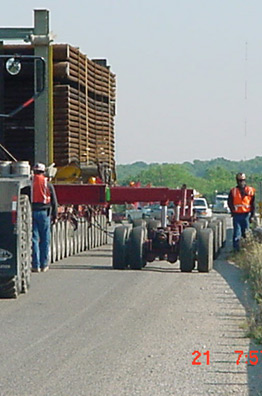|
|

Rank: Advanced Member
Groups: Member
, Moderator
Joined: 1/15/2007
Posts: 4,089
|
I have been being kept up to date on the big 800+ ton transformer move by friend, Mr. X, at Mammoet and he has shared some real cool pictures and info with me, which I would like to pass on.    And some commentary: Attached, please find two photos of the Toshiba Turbine transportation through South Carolina. The unit is presently in Chesnee, SC going through a trailer re-configuration for the final leg of the trip to Cliffside, NC.
Location is still on Route 11, and will be for three to five days, then will proceed across the Route 11 and 221 junction in the center of town to Route 221 Alternate and onto the power plant.
The pix are to show the trailers with out riggers in use and not in use - to give you an idea of how they are used. All the hydraulics are in sync to distribute the load on an equal basis.I asked about if these outriggers were a Mammoet innovation and the reply was: These out-riggers were engineered and fabricated by Mammoet for this and several future projects.And then I received a follow up email with even more info: The out-rigger system is used to dis-place the weight while in transit - and as you said - to give the total load and transporters a larger foot print.
If - when stored - the load can be raised, and matts placed under the load if need be.
The larger foot print is needed die to road conditions - under ground utilities - and bridge weight factoring. In towns where old mills were once present, there are large red brick water and sewer lines below. In other areas there are large old concrete storm water lines. Road conditions are sub road bed thickness, sandy soils, clat, and surface thickness. Bridges, weigh displacement, beam locations, etc.And finally some engineering info: The 'arms' are hydraulically pushed out and locked.
The complete assembly is a bolt on unit.
The 'arm' end has a plate to lock the hydraulic jacking house mover in place.
The house moving dollie can be lifts by it's own double action hydraulic ram leaving the dollie suspended if need be.
The hydraulic jack or ram circuitry is tied into the T-HP hydraulics system to equalize the loading and leveling.
The unit used for the Cliffside project has 20 of these arms and dollies.
When the dollie/out rigger system is not in use, the dollies are transported via trailer in the support convoy. The arms swing back to the body of the T-HP and are secured until needed.
The out rigger system can by used on other units as needed - not just limits to this project and T-HP system.Pretty cool stuff! I would like to thank Mr. X for answering my questions and allowing me to share this real cool information.
Bob Bobs CranesCome Over To The Lift Side . . . . . . . We Have Cookies!!!!
|
|

Rank: Advanced Member
Groups: Member
Joined: 1/9/2007
Posts: 1,076
Location: Downers Grove, IL
|
|
|

Rank: Advanced Member
Groups: Member
Joined: 3/24/2007
Posts: 1,492
Location: Newfoundland, Canada
|
Great stuff Bob!! Those guys (and gals) at Mammoet are great! They have always been a help to me as well.....
Greg
|
|
Rank: Advanced Member
Groups: Member
Joined: 8/3/2003
Posts: 780
Location: Pennsylvania
|
I must say, a very impresive move. Some great info. Also, must add. The use of HMDs (house moving dollies) and outriggers is not a Mammoet innovation. This is a practice that is, and has been used by many HH companies for many years.   
|
|

Rank: Advanced Member
Groups: Member
Joined: 8/24/2006
Posts: 2,185
Location: Grapevine, Tx
|
Great thread Bob!! You must thank Mr. X for us, what a great piece of info on the HUGE heavy haul.
Thanks bluebarn and your friend for his pics.
Jeff
|
|

Rank: Advanced Member
Groups: Member
Joined: 10/30/2006
Posts: 889
Location: Las Cruces, NM
|
1:1 or 1:50, I am still in awe. 
|
|
|
Guest |
